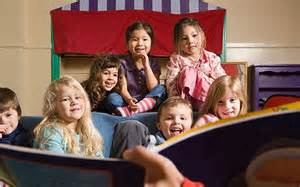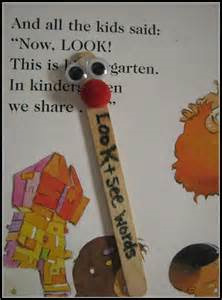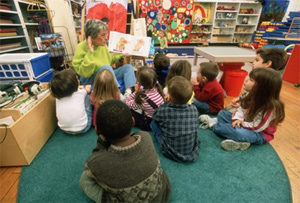Six Early Literacy Skills
The first edition of ECRR focused on six early literacy skills based on the work of Dr. G. C. Whitehurst and Dr. C. J. Lonigan. These early skills set the stage for reading development. They were not listed in a particular order, and were not intended as a hierarchy of skills, but rather an interacting set of skills that work together to help a child become ready to read. With the development of ECRR 2, Dr. Susan B. Neuman and Dr. Donna Celano applied new additions to the research base that expanded the understanding of the implications of these six important areas. ECRR 2 identifies which of these skills are constrained skills (skills with a fixed endpoint that must be mastered in order to learn to read or decode the printed word, and are strongly predictive of early reading success) and unconstrained skills (skills that contribute to comprehension and that continue to develop over a lifetime; providing the foundation of not only reading success, but future academic success). ECRR 2 focuses on both types of skills, but places stronger emphasis on unconstrained skills that develop language and background knowledge. It does so in the form of five practices: talking, singing, reading, writing, and playing.
The following is an explanation of the six early skills, why they are important to school readiness and reading development, and whether they represent a constrained or an unconstrained skill area.
 1) Vocabulary
1) Vocabulary
Vocabulary skills refer to knowing the meanings of words. Children need many opportunities to build vocabulary knowledge before starting school. A good listening and speaking vocabulary is the foundation of reading. If children start school with a good vocabulary, they will have a greater likelihood of:
- Understanding lessons and directions
- Participating in class by asking and answering questions
- Learning to read words easily because they already understand the meaning of many words
* Vocabulary is an unconstrained skill area.
 2) Narrative Skills
2) Narrative Skills
Narrative skills refer to a child's ability to describe things, talk about events, and tell stories. Conversations with adults, particularly about books, build narrative skills. If children start school with strong narrative skills, they will have a greater likelihood of:
- Being attentive when the teacher shares books and stories
- Actively listening for a sequence, or order, of events
- Using their background knowledge to comprehend what is read
* Narrative skills connect to vocabulary development, background knowledge, and comprehension, which are unconstrained skills.
 3) Print Awareness
3) Print Awareness
Print awareness refers to knowing how to handle a book and noticing that print is everywhere. Children who have print awareness know how to hold a book right side up and turn the pages one at a time. They realize that the print is what you are reading and that print has meaning. If children start school with early print awareness skills, they will have a greater likelihood of:
- Learning how to track the words on a page or chart
- Learning the conventions of print, such as capitals and periods
- Being eager to learn to read
* Print awareness is a constrained skill area.
 4) Phonological Awareness
4) Phonological Awareness
Phonological awareness refers to being able to hear and play with the smaller sounds in words. Learning to pay attention to the sounds in words is an important step toward being ready to learn to read. Nursery rhymes, songs, and books with language play help build phonological awareness. If children start school with phonological awareness skills, they will have a greater likelihood of:
- Catching-on to phonics instruction
- Learning how to spell words
- Learning how to write independently
* Phonological awareness is a constrained skill area.
 5) Letter Knowledge
5) Letter Knowledge
Letter knowledge refers to knowing that letters are different from each other and knowing letter names and the sounds they make. Letter knowledge helps children discover the code of reading and writing words. If children start school with some letter knowledge, they will have a greater likelihood of:
- Mastering grade level phonics instruction
- Learning to read and write easily
- Becoming fluent readers
* Letter knowledge is a constrained skill area.
 6) Print Motivation
6) Print Motivation
Print motivation refers to having an interest in reading and enjoying books. Surrounding children with a variety of books and positive experiences with book sharing will build print motivation. If children start school with print motivation, they will have a greater likelihood of:
- Being excited about learning to read
- Choosing reading as a free-time activity
- Becoming life-long readers
* Note: Print motivation is critical to reading and school success, and not just in the early years. Though not usually referred to as a skill, the importance of motivation to reading success throughout school is well documented. In that sense, print motivation can be thought of as an unconstrained skill area related to vocabulary, background knowledge and comprehension. The more you read, the more you know!
